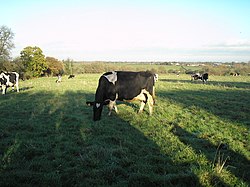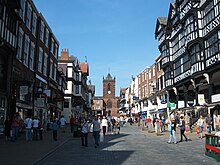Chester (cheese)

Chester cheese or shortly Chester [ tʃɛs.tə ] ( ) (Engl. Cheshire [ tʃɛ.ʃə ] cheese ) is an English cheese made from cow milk with at least 48% fat in the dry matter , the Matures for at least four to eight weeks, but can also be stored for well over a year.
The cheese bears the name of the county in northwest England from which it comes, Cheshire , formerly County of Chester , with the capital Chester . The cheese is mainly produced there and in the neighboring counties of Denbighshire , Flintshire and Shropshire , which is due to the fact that County Cheshire was a lot larger than it is today at the time the cheese was named. Since the name of the cheese is not protected, counterfeit products can be found under this name in many parts of the world.
history
Cheese making was probably introduced to the Cheshire region by the Romans ; it is also possible that they found a local cheese production that they further developed. Castra Devana, as the city of Chester was called in Roman times, was already an important trading point for cheese in ancient times. After the withdrawal of the Roman troops, the tradition of cheese-making was continued by the Britons.
The Cheshire is considered to be the oldest known cheese in Great Britain; it is first mentioned in writing in the Domesday Book completed in 1086 , an imperial land register drawn up at the instigation of Wilhelm the Conqueror .
After a plague in Suffolk in the 1640s , from where the Royal Navy in particular had large quantities of cheese delivered to London , sales of Cheshire cheese in the capital skyrocketed, as reports from the port authorities show from 1650 . In that year, in addition to the normal commercial routes overland, Cheshire was also transported by ship from Liverpool to London to meet the increasing demand.
In the late 18th century, Cheshire became one of the most important cheeses on the English market after the Navy decreed in 1758 that their ships should be supplied with supplies from Cheshire and Gloucester for their own use instead of the previously common, cheaper cheeses . By 1823 annual production at Cheshire, England was an estimated 10,000 tons.
In Germany, too, cheese was already known and highly valued at the turn of the 18th and 19th centuries, as demonstrated by the detailed appraisal of Chester under the heading cheese in the Economic Encyclopedia founded by Johann Georg Krünitz . There it also becomes clear that it is not so easy to imitate a real Cheshire, even if you know the method of preparation, since the consistency of the milk used plays a decisive role in the quality of the cheese. It is expected of original Cheshire that the cows that supplied the milk could graze on the wide, salty pastures of the Cheshire Plain (Cheshire Gap) . The hollow channel on this plain between the hills of North Wales and the Peak District of Derbyshire was pushed out by an Ice Age glacier , which, as it retreated, left many dead ice holes lined up like pearls , which are small lakes and ponds that shape the landscape to this day. The soils of the region have rich salt deposits near the surface. These salts evidently give the milk of the cows grazing here a special texture and flavor, which also characterizes the cheese as an end product. For this reason, for a long time only Cheshire, which was produced between around May and October, as long as the cattle grazed in the open, could be sold in long-distance trade at good prices. The milk from winter feeding with hay or silage was used for the region's own needs.
Until the late 19th century, the various varieties of Cheshire were usually stored longer than is common today before they were sold. Older Cheshire is more solid and therefore more suitable for surviving the adversities of horse-drawn carriage on bumpy roads and by sailing ship on the high seas unscathed. Younger, fresher and also more crumbly Cheshire, as it is mainly produced in a similar form today, did not begin to establish itself until the end of the 19th century, especially in the industrial regions in the north of England and the Midlands . The reasons for this were less taste than financial motives, as young cheese could generally be produced and sold more cheaply due to the shorter storage time. Sales in Cheshire peaked around 1960 at around 40,000 tons per year, but have been falling steadily since then due to the increasing selection of other cheeses. Still, at 6,500 tons annually, Cheshire is the UK's top-selling cheese. Since the name is not protected by trademark law, many other manufacturers around the world also produce cheese using the Chester or Cheshire method and call it that. In terms of consistency and taste, however, the result often falls short of the expectations that gourmets have of real Cheshire.
Manufacturing
The actual making of Cheshire only takes two to three hours. The milk from the morning milking session is mixed with that from the previous evening, if necessary pasteurized and then mixed with a starter culture of lactic acid bacteria in order to prepare the milk for maturation. Then bringing the acidified milk with rennet to coagulate . After coagulation, the resulting jelly is cut with a cheese harp up to a grain size about a grain of wheat. The resulting curd and whey mixture is then stirred - with more and more whey being secreted - until the desired strength of the curd is reached (approx. 100–120 min). The whey is then separated off, the curds are salted, ground and filled into barrel-shaped molds, in which they are pressed for one to two days. The cheeses can then be removed from the molds and stored in cool cellars, where they are cared for until the desired maturity. Maturing takes at least four to eight weeks, but the cheeses can mature for well over a year, with the taste becoming sharper as the cheese matures. Some manufacturers still use raw milk exclusively for Cheshire, while industrial producers use pasteurized milk. A cattle breed popular with dairy farmers in the area is the Holstein-Friesian.
variants
A typical Cheshire usually has the shape of a barrel about 30 centimeters high with a diameter of 20 centimeters, a weight of about eight kilograms and a fat content of at least 48% in the dry matter. According to gourmets , Cheshire cheese dough has the best balance between a pleasant, slightly salty aroma and a moist, crumbly texture when it is four to six months old. The tastes diverge here, however, so that one will prefer young, mild and juicy cheese, while another may particularly appreciate well-matured Cheshires with their intensely spicy to pungent aroma.
Four types of Cheshire are common in trade:
- White Cheshire ranges in color from whitish-gold to yellow, depending on its age, and is produced without any additives.
- Red Cheshire with an intense orange to red color, which is achieved by adding annatto . The vegetable coloring enriches not only the color, but also the taste of the cheese with fullness and its own pleasant, light bitter note.
- Blue (veined) he Cheshire , which is also traded under the name Shropshire. The blue veins of this variety are caused by noble mold that spreads in the fine hairline cracks of the cheese during ripening. The blue variant was once generally regarded as undesirable incorrect ripening, but is now increasingly appreciated by consumers because of its interesting aroma and can therefore be better marketed.
- Smoked Cheshire (Smoked Cheshire cheese) is made from white or red Cheshire. Originally the method of smoking was mainly used to improve the shelf life of the cheese. Today, despite modern cooling systems, many smaller producers are mainly thinking back to this because they want their cheese to stand out from the industrial mass-produced goods with the special taste component of the smoke aromas and to emphasize the artisanal production. Before smoking, the barrel-shaped cheese wheels are cut into four slices so that the flavors penetrate the dough better. Oak wood is the ideal fuel for smoking . The smoking process turns the rind and outside of the cheese slices a strong golden brown color and takes on a strong smoky taste, while the inner dough becomes a little pale through the smoking process.
There are also some manufacturers who make Cheshire cheese with milk from organic farming and who comply with all the criteria of the EU organic regulation during production so that their cheese can be labeled with the organic seal in Germany .
Some sources consider Cheshire to be a variety of Cheddar because of the similar manufacturing process . This is countered by the fact that the optimal state of ripeness for Cheshire is generally set earlier by experts at four to six months than for Cheddar, which, according to the majority of opinion, only reaches its best stage after more than a year of ripening.
Other meanings
- Ye Olde Cheshire Cheese is the name of a historic London pub near Fleet Street and is similarly copied by many other shops and pubs.
Web links
- Nelson and His Navy - Cheese and the Navy ( Memento August 8, 2007 in the Internet Archive )
Individual evidence
- ^ Uni Trier: Krünitz Online about Chester cheese
- ↑ Teddington Cheese (retailer name) via Appleby's Cheshire ( memento of the original from March 12, 2006 in the Internet Archive ) Info: The archive link was automatically inserted and not yet checked. Please check the original and archive link according to the instructions and then remove this notice.

